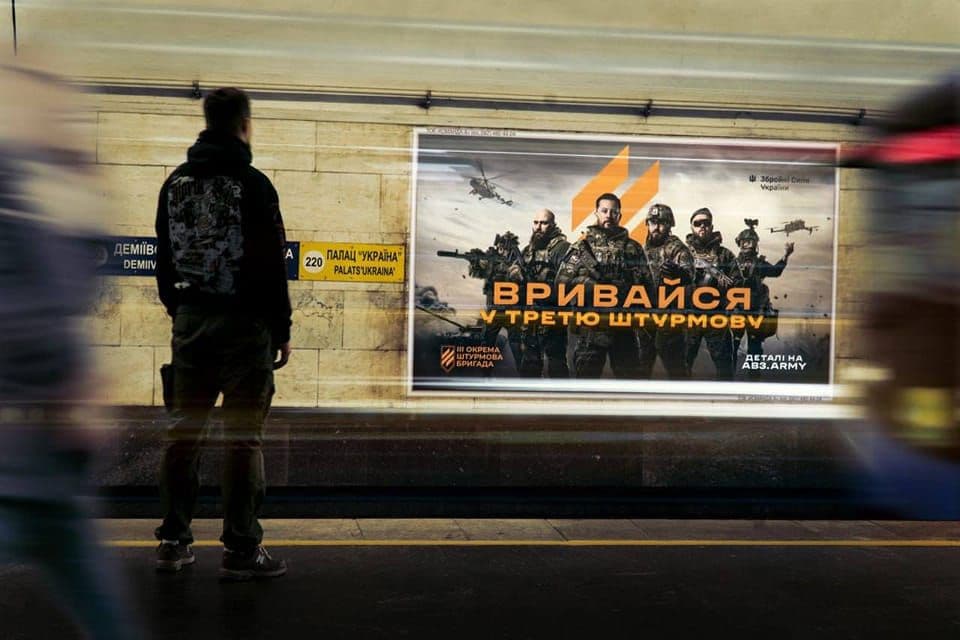Ukraine struggles to ramp up mobilization as Russia's war enters 3rd year

As Russia’s full-scale war approaches its third year and looks ready to drag on for several more, one topic is dominating the discussion in Ukraine: mobilization.
From regional capitals and small villages to the front lines of the east, from the media, the workplace, and the family, Ukraine’s acute need to mobilize hundreds of thousands more men to stay in the fight against Russia is felt everywhere.
With it comes one of the most difficult internal challenges that Ukraine faces in this war: balancing the need to defend the country’s independence from an existential threat with the painful reality of having to take hundreds of thousands of civilians — taxpayers, fathers, brothers, husbands, and sons — off to war.

Although Ukraine has been conducting rolling mobilization since the full-scale invasion began in 2022, the topic soared to the top of the domestic agenda on Dec. 19, when President Volodymyr Zelensky announced at a press conference that the military had requested the mobilization of an additional 450,000-500,000 conscripts.
“The president understands perfectly well that if he doesn't give the green light to mobilization, soon there will be nobody to fight with,” military political analyst and co-founder of the Information Resistance project Oleksandr Kovalenko told the Kyiv Independent.
A week later, a new draft law on mobilization was submitted by Ukraine’s Cabinet of Ministers to the Verkhovna Rada, the country’s parliament. Inside the 72-page document were measures seeking not only to expand the groups of Ukrainian men eligible for the draft, but also to increase the consequences for avoiding it.
Once the draft law was made public, debate on its points quickly erupted both in parliament and in society at large, with the Armed Forces’ Commander-in-Chief Valerii Zaluzhnyi holding a special press conference on Dec. 26 to clarify aspects of the document.
Despite intense frequent meetings between parliamentary committees and representatives of the military and Defense Ministry, the draft law was sent back to the government for revision on Jan. 11, with lawmakers and experts raising concerns about risks of human rights violations and corruption within the provisions of the document.
Unavoidable need
In a nondescript yard outside an unfinished building on the outskirts of Dnipro, a dozen people in civilian winter clothes patrol the area with automatic weapons. In groups of six, they practice basic assault exercises, clearing the building with rocks instead of grenades.
At this stage in the war, the growing gap between the military and civilians is often talked about, but some units are still trying actively to change that.
The group, split evenly between men and women, is taking part in a civilian preparation course organized by the Ukrainian Volunteer Army, designed to teach civilians basic skills in weapons handling, squad-level drills, and tactical medicine.
Leading through their paces is a tall, straight-talking combat medic with the callsign “Vakula,” who declined to give his name as he still has relatives in his occupied home town of Donetsk.

The courses are not held primarily as a recruiting tool, Vakula said, and so far only one person has chosen to join the unit’s ranks after participating.
“In people's eyes, even on these courses, I often see some kind of apathy,” he said.
“At first everyone wanted to fight and there weren't enough weapons, but now it's clear that initial fire is gone; if it was still there, the situation on the battlefield would be easier for everyone.”
By now, both Russia and Ukraine are fighting with armies dominated by mobilized soldiers; the scale of one of the most brutal state-against-state wars since World War II demands it.
Much less territory changed hands in 2023 compared to 2022, but at the same time, the intensity of the fighting has only steadily increased, as the two sides commit more and more resources to a struggle that is of existential importance both for Vladimir Putin’s imperial vision as it is for Ukraine as a nation.
In this context, Ukraine’s need to mobilize hundreds of thousands more soldiers over 2024 is objectively clear, as reflected in the 450,000-500,000 number initially voiced by Zelensky.
Newly mobilized soldiers are required both to refill the ranks of units that have suffered casualties in the intense fighting, and to create fresh reserves which can be used either for future offensives or to rotate units that have been exhausted after long stints on the front line.
With no current expiry date on the military contracts of mobilized Ukrainians, calls for soldiers’ eventual demobilization have also become louder recently. The initial draft law presented by the Cabinet of Ministers called for contracts to be set at 36 months, while alternative proposals from opposition parties set the number as low as 18 months.
In any case, demobilized soldiers themselves will have to be replaced with more conscripts, Zaluzhnyi noted at his press conference in December.
“Of course I would want for the people going into the military, especially those already serving, to understand exactly how long they will have to fight for,” Zaluzhnyi said.
“We (the General Staff) agreed on the figure of 36 months with the Defense Ministry, hoping for two things: that there won’t be an intensification on the front line, and, most importantly, that there will be somebody to replace these people with.”

For soldiers like Vakula, who is nearing two years of service, the mobilization debate sharply reflects how differently soldiers and civilians carry the burden of the war.
“People need to be reminded that the war isn't over yet,” he said.
“We are tired of the war just like them, but while their tired selves can come home to a warm bed, our tired selves will get an order to reload the mortar, fire off a few more rounds and return to our freezing dugout.”
Tricky compromise
The tone for Ukraine’s difficult mobilization debate was first set at Zelensky’s press conference, before the draft law was introduced.
"This is a serious number. I said I need more arguments to support this direction," the president said, when first revealing the military’s alleged target of 450,000-500,000.
“I also want to defend civilians for one second,” he later added. “When we are talking about mobilization, it takes six civilians paying taxes to provide for one fighter.” Later, in an interview with Channel 4 published on Jan. 20, Zelensky once again argued that the 500,000 figure would be too much.
These comments established the ground rules for the passing of new mobilization legislation: this was to be a compromise between the military with their clear need for laws to help them expand the mobilization process, and the civilian leadership looking to “protect” the interests of civilians from outwardly draconian or unconstitutional measures.
“This draft law needs to take shape through tight cooperation between the country's military and political leadership,” said Kovalenko. “This is a very difficult discussion because often politicians don't understand military matters and vice versa.”

Reaching consensus was made even more difficult due to the fact that within the parliament, further disagreements arose between different political parties, each looking to present themselves as pushing a version of the law more likely to please future voters.
By Jan. 9, when negotiations in the committees were still ongoing, five separate versions of the draft law had been put forward by different groups of lawmakers.
“To imagine the Verkhovna Rada without political games is difficult,” said Roman Lozynskyi, a lawmaker from the “Justice” (Spravedlyvist) parliamentary group, who served in the Armed Forces for a year at the onset of the full-scale war, to the Kyiv Independent.
“Even though the country has been in a full-scale war for almost two years, politicians are, according to the laws of nature, still thinking about their future, their rating, and so on,” he said. “This affects the making of unpopular decisions, nobody wants to take responsibility for that.”
The initial draft law contained several key measures to standardize and widen the scope for mobilization, most of which were quickly contested in the parliamentary committees.
These included the lowering of the draft age from 27 to 25 with basic military service compulsory between 18-25, the removal of exemption for men in the least severe disability group, the involvement of local government in the conscription process, and the addition of draft dodgers to the debtors’ register.

Concerns were raised in both the committees and by Ombudsman Dmytro Lubinets that some of the measures enclosed not only risked facilitating corruption, but violated the country’s constitution.
According to lawmaker Anastasiia Radina, who heads the parliament’s Anti-Corruption Committee, parts of the draft law which created particular risk for corrupt activities included the involvement of local government in mobilization activities, as well as the section concerning the debtors’ register.
“The head of the enlistment office should not be able to enter someone into the register the day after not showing up (after all, that could have a good reason), while “not noticing” someone else for months,” Radina wrote on Facebook.
Another contentious element of the document was the introduction of electronic summons notices, making use of Ukraine’s world-leading electronic government services infrastructure.
Although some of the alternative draft laws proposed to do away with the cause on electronic summonses, parliament quietly passed a separate law to create a unified electronic database for draft-eligible men.
“I think that all these technical questions in the draft law can be sorted out with a compromise,” said Lozynskyi.
“Was the draft law in good shape to be accepted in the first reading? No. There weren't enough closed, non-politicized discussions around it. There wasn't enough input from different bodies, including the military.”
Fear of the streets
While it’s the battlefield units that need the new recruits and the parliamentarians that must agree on the laws of mobilization, the task of physically conscripting civilians falls to the most-maligned state institutions in Ukraine: local enlistment offices.
These facilities, which fall under the purview of the Armed Forces, itself under the authority of the Defense Ministry, were inundated with young Ukrainians eager to fight in the first days of the full-scale invasion. Those days are long gone.
The job of taking civilians to war is unenviable on its own, but their public image across the country is made worse by a reputation for corruption and methods that are often brash, and sometimes even violent.
In August 2023, Zelensky personally dismissed all of the regional enlistment office heads, a response to the nation’s contempt for the institution after many cases of abuse and corruption, including that of the Odesa regional head, who had bought property worth millions of dollars in Spain during the war.
On the ground, the move seemed to do little to change the culture or practices of the enlistment officers.
In scenes reminiscent of the forced mobilization of young men by Russian proxy forces in the occupied territories, videos regularly emerge on social media of Ukrainian men being packed into minibuses by armed, uniformed enlistment officers.
Many men eligible for the draft subscribe to local Telegram channels that warn residents of where summons notices are being handed out. According to one local enlistment officer in the northern Ukrainian city of Chernihiv, over 21,000 locals were subscribed to such a channel in the city as of July 2023, roughly equivalent to the number of those who had dodged the draft.
“I don't go out onto the street at all,” said Mykhailo, a 31-year-old resident of the western Ukrainian city of Chernivtsi, whose first name has been changed to protect his identity.
For Mykhailo, an IT specialist who says he regularly donates to the Armed Forces through trusted fundraisers, the choice to remain at home is driven by a surreal double motivation, to avoid not only being drafted on the street, but also the moral guilt of enjoying oneself outside as a military-aged male.
“I remember someone saying that if you don't join the army, have some respect, don't go hanging out at cafes, restaurants and ski resorts, and so on,” he said. “I understand how it limits me, but if I were to walk around the city, the kind of things that the recruiting officers are doing could happen to me too.”
Among others, Chernivtsi Oblast has been notorious for scandals involving the alleged misconduct of enlistment officers. On Jan. 19, local media reported the alleged kidnapping of two musicians from Kyiv by recruiters in Chernivtsi, who claimed they were severely beaten and forced to undertake a military medical.
“From the perspective of ordinary people, it is scary; when you have these ‘assaults’ of shopping centers and so on, sometimes in masks… why are they hiding their faces?” said Mykhailo. “It just looks like pure kidnapping of people to be honest.”

On top of the physical manhandling often involved, the military medicals conducted at the offices have also gained a poor reputation for neglect and corruption.
Mykhailo, who often suffers from chronic pain after a spinal injury, worries that he could be forced into a military role that not only makes no use of his IT skills, but could be completely unsuitable given his conditions.
“Maybe I would be ready to go to the medical commission if I could be sure that they would take my physical conditions into account,” he said, “and not just say 'You're fine' and put me on, for example, a machine gun, because that would be certain death.”
Although the work of the enlistment centers has significant bearing on society’s attitudes to mobilization as a whole, changing this was not a prominent element of the initial draft law.
“Of course, these scandals with the enlistment centers and officers don't help,” said Kovalenko.
“In a country fighting a full-scale war, the recruiters' legal powers to do their job should be expanded significantly, but there should also be clear boundaries set, and this isn't being done, which makes everything worse.”
For many Ukrainian men, even beyond all the issues with the enlistment process, other reasons make the basic prospect of going to war a distressing one. In Mykhailo’s case, this is the imminent birth of his first child.
“I understand that the war will be long,” he said. “If they take me to the military now for some unknown, indefinite period of time... I don't want my daughter to look at me like some kind of unknown uncle. There are many, many people who have the same concerns.”
No other option
As of late January 2024, the expected new version of the draft law has yet to be presented; Defense Ministry representatives have said that it will likely arrive in the first week of February.
“There is a lot of work being done now; the Defense Ministry in particular is making a colossal effort to make the next draft law as strong as possible,” said Lozynskyi; “lots of MPs and experts from outside politics are part of this effort as well.”
“We don't have months or years to discuss this, our enemy continues to attack and we must take steps to ensure the rotation of the people who have been defending the country for two years already.”

With battlefield prospects darkening and internal politics returning with a vengeance, the way Ukraine grapples with the challenge of mobilization looks to serve as a litmus test for the country’s ability to handle the enduring pressure of the war as a whole.
“It's not a conflict of interests, it's a conflict of worldviews,” said Kovalenko. “The military understands very well what war is and how it could end for the country, while many civilians have gotten used to this new ordinary life, and they don't want to face the reality that everyone needs to be ready to fight.”
UItimately, so long as Russia continues to attack and Ukraine continues to resist, the reality that hundreds of thousands of Ukrainian civilian men must enter the ranks of the military is unavoidable.
“A lot of people don't quite understand the need for mobilization, maybe they think that the war is far away and they (the military) can manage fine,” Kovalenko added; “they don't think about what could happen to the country if they don't manage.”
Note from the author:
Hi, this is Francis Farrell, cheers for reading this article, it was not an easy one to write; being involved in the war and supporting your country to the best of your abilities is one thing, but having the threat of being killed in trench warfare hanging over you personally is another entirely. However difficult the topic, we won't shy away from it. Please consider supporting our reporting.

















